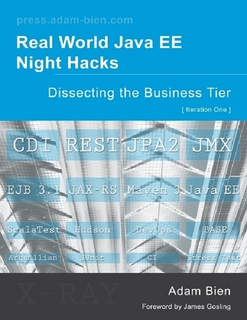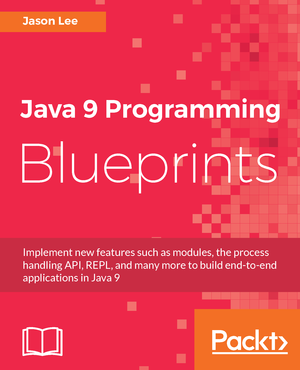2014
October
-
Book Review: RESTful Java Patterns and Best Practices
I recently received a copy of RESTful Java Patterns and Best Practices, by Bhakti Mehta for review. Here are my thoughts on the book.
June
-
Book Review: JavaFX 8: Introduction by Example
Carl Dea, this time with the help of Mark Heckler, Gerrit Grunwald, José Pereda, and Sean Phillips, recently published an updated and greatly expanded introductory work on JavaFX, with both the title and content updated to reflect the updates in the JDK and library.
tl;dr: A solid introduction with a plethora of usable examples. You can purchase it here.
March
-
Book Review: Java EE and HTML5 Enterprise Application Development
I was recently sent a copy of Java EE and HTML5 Enterprise Application Development by John Brock, Arun Gupta, and Geertjan Wielenga. This is my review of the book.
-
Book Review: 50 Android Hacks
 50 Android Hacks by Carl Sessa is, as you may have deduced from the title, a collection of 50 tips and tricks to help Android developers of all skill levels handle a variety of problems. For the most part, I found the book very helpful. Before I get to that, I have a minor quibble: I’m not sure "hacks" was the best choice of words. I understand the marketing aspect of it, but when I hear "hack", I think of a piece of code I’m embarrassed to share with someone else, of something I’d prefer to hide. These "hacks" seem anything but. Clean, clear, efficient, something to be proud of. It’s a minor quibble, of course, but there it is. :)
50 Android Hacks by Carl Sessa is, as you may have deduced from the title, a collection of 50 tips and tricks to help Android developers of all skill levels handle a variety of problems. For the most part, I found the book very helpful. Before I get to that, I have a minor quibble: I’m not sure "hacks" was the best choice of words. I understand the marketing aspect of it, but when I hear "hack", I think of a piece of code I’m embarrassed to share with someone else, of something I’d prefer to hide. These "hacks" seem anything but. Clean, clear, efficient, something to be proud of. It’s a minor quibble, of course, but there it is. :)The book itself is pretty easily laid out. If you’ve read a "cookbook", then you should be comfortable and familiar with the basic layout. Each chapter is a different tip, which range from the "easy" (e.g., centering text in a view) to the more advanced (e.g., using the SyncAdapter). The topics covered include layouts, animations, build tools and more.
I read this, appropriately enough, using the Kindle App on my Android tablet, and the experience was very good. I’ve read several programming books on my tablet, and they usually have issues with unreadable source code, large blanks due to content flow issues, etc. Some of this is affected, of course, by the font size and is fixable, but I saw none of those issues here. All of the source, both XML and Java, were neatly formatted and readable, with no odd, jarring line wrap issues. The graphics were crisp and readable, and the pages were neat and clean.
This is a great book, especially for beginning to intermediate Android developers, but I’d wager that there’s something here for just about everyone.
2013
October
-
Book Review: Instant Vert.x
I recently acquired a copy of Instant Vert.x (Kindle version here) by Simone Scarduzio. It’s a short book (54 pages), so here’s my short-ish review. :)
September
-
Book Review: Beginning Java EE 7
Java Champion and JUG leader Antonio Goncalves recently released his third book on Java EE, Beginning Java EE 7. Just from the title and the table of contents, it’s clear that Antonio set a very ambitious goal for this book, and I think he delivered what he promised.
2012
April
-
Book Review: Pro JavaFX 2: A Definitive Guide to Rich Clients with Java Technology
image::http://www.apress.com/media/catalog/product/cache/9/image/9df78eab33525d08d6e5fb8d27136e95/A/9/A9781430268727-3d_11.png
I was privileged to be given a copy of the recently released Pro JavaFX 2: A Definitive Guide to Rich Clients with Java Technology
from Apress, authored by https://twitter.com/!/JavaFXpert[James] Weaver, https://twitter.com/!/weiqigao[Weiqi] Gao, https://twitter.com/!/steveonjava[Stephen] Chin, https://twitter.com/!/deanriverson[Dean] Iverson, Johan Vos. This review is a bit overdue, but I hope you find it as helpful as I found the book.
2011
November
2010
August
-
Book Review: JSF 2.0 Cookbook
image::https://www.packtpub.com/sites/default/files/imagecache/productview/9522.jpg
Packt Publishing recently released a book titled JSF 2.0 Cookbook, by Anghel Leonard. When I first heard about this book, I was really anxious to get my hands on it. I really like the cookbook concept, so I was excited to see a work in that vein published for JSF. Packt recently sent me a copy to review, so, having read most of the book, here are my thoughts.
First off, I’ll be upfront: I have not read the whole book, but I don’t think that’s a problem. Cookbooks aren’t meant to be read cover to cover, necessarily. While you can certainly do that, these types of books are intended to be a reference. When you have an issue, you look in the table of contents to find the "recipe" that covers your issue, and jump to that page. That’s what I did with this book, mostly. I looked up the recipes for issues I most often have trouble with. I did, though, read almost all of the custom component chapter, as that’s area that holds a lot of interest for me. I’ll give that one special attention in a moment.
Each recipe, follows the same basic pattern. It starts with a basic summary of the problem, then goes in to "Getting ready," "How to do it…," "How it works…" and "See also." There are minor deviations along the way, but that’s the basic gist. In the Getting Ready section, the author details how the recipe was created (NetBeans 6.8, Mojarra 2.x, and GlassFish v3, showing the author has great tastes : ), so new users can get a sense of what might help work through the recipe. The How to do it section is pretty detailed, with LOTS of source code. Much of the markup is still using JSP, which is a shame since JSP is all but formally deprecated with JSF 2.0 (Facelets being the de facto standard), but you shouldn’t have any major issues applying what you see to a Facelets page. The How it works section that follows does a great job of explaining…err… how it works, which I think is really important. How to do something is rarely enough. If you understand why to do something and how that something works, you’ll be better equipped in the future for similar, but slightly different issues. This section does a good job of that.
The only area of the book I want to comment on specifically is Chapter 5, Custom Components. Of all the areas in JSF, component authoring has always been a favorite of mine. I am far from being a leading expert, but I’m pretty comfortable with it and really enjoy it. Chapter 5, then, was one of the first things I turned to. The author does a great job of giving a variety of examples using validators, ajax, etc. A big glaring flaw for me, though, was the discussion of the JSF lifecycle, a very important topic for component authors. In the graphic on page 130, encoding is shown as happening in the Apply Request Values Phase, and decoding is shown as happening in the Render Response Phase. Unless I’m sorely mistaken, that’s exactly backwards. Despite that error, the chapter itself is extremely helpful. I would advise, though, that if you are looking to learn component development, to try JavaServer Faces 2.0: The Complete Reference by Ed Burns, and Chris Schalk, or Core JSF by David Geary and Cay Horstmann. That’s not to belittle this book in anyway. The Geary/Hortsmann and Burns/Schalk books are meant for different purposes. JSF 2.0 Cookbook has a slightly different purpose, which is complementary to the first two, and which it does well, I think.
Overall, I think this is a really good book. Though not perfect, it provides a lot of value to the JSF developer. From beginner to expert, I think there is enough in this book to help just about everyone out of a jam from time to time.
June
-
Book Review: JSF 1.2 Components
Some time ago, I was given a copy of JSF 1.2 Components by Ian Hlavats and asked if I’d write a review for it. It’s long overdue, but here are my thoughts on this book.
2009
April
-
Book Review: Practical RichFaces
One of the great strengths and successes, I think, of the JavaServer Faces specification is the proliferation of third party components. One of the older and better known component sets is RichFaces, which started out under a company called Exadel and is now part of JBoss. For many, RichFaces is the first add-on component set for a new JSF project, and with good reason. I recently had the opportunity to serve as a technical reviewer on Max Katz’s Practical RichFaces from Apress. Read on for my review of the book.

 My name is Jason Lee. I am a software developer living in the middle of Oklahoma. I’ve been a professional developer since 1997,
using a variety of languages, including Java, Javascript, PHP, Python, Delphi, and even a bit of C#. I currently work for Red Hat
on the WildFly/EAP team, where, among other things, I maintain integrations for some MicroProfile specs, OpenTelemetry, Micrometer,
Jakarta Faces, and Bean Validation. (Full resume
My name is Jason Lee. I am a software developer living in the middle of Oklahoma. I’ve been a professional developer since 1997,
using a variety of languages, including Java, Javascript, PHP, Python, Delphi, and even a bit of C#. I currently work for Red Hat
on the WildFly/EAP team, where, among other things, I maintain integrations for some MicroProfile specs, OpenTelemetry, Micrometer,
Jakarta Faces, and Bean Validation. (Full resume 